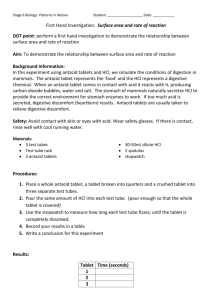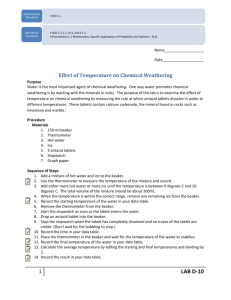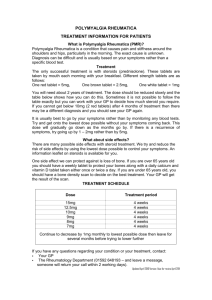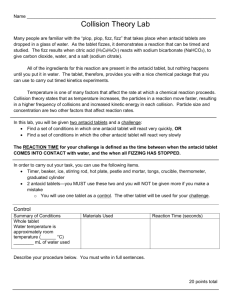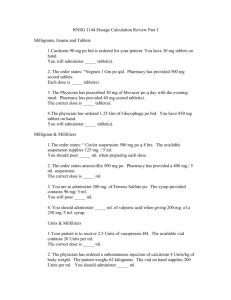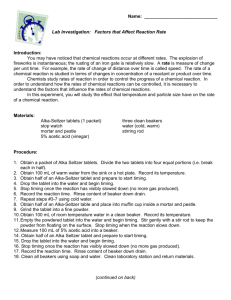antacid lab
advertisement
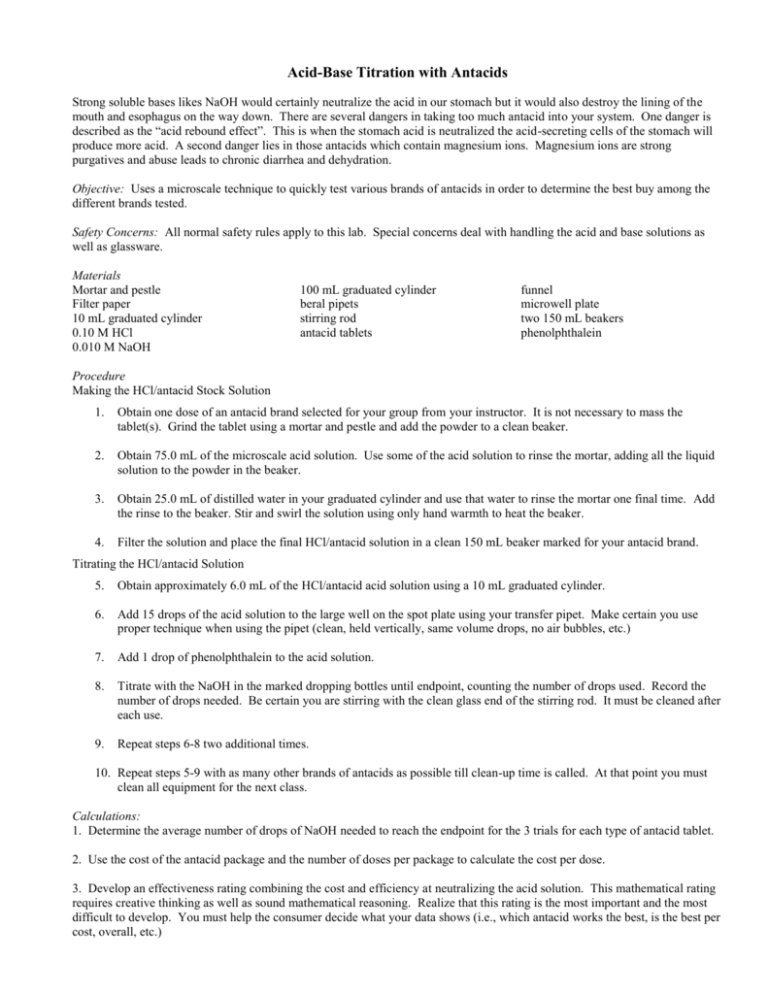
Acid-Base Titration with Antacids Strong soluble bases likes NaOH would certainly neutralize the acid in our stomach but it would also destroy the lining of the mouth and esophagus on the way down. There are several dangers in taking too much antacid into your system. One danger is described as the “acid rebound effect”. This is when the stomach acid is neutralized the acid-secreting cells of the stomach will produce more acid. A second danger lies in those antacids which contain magnesium ions. Magnesium ions are strong purgatives and abuse leads to chronic diarrhea and dehydration. Objective: Uses a microscale technique to quickly test various brands of antacids in order to determine the best buy among the different brands tested. Safety Concerns: All normal safety rules apply to this lab. Special concerns deal with handling the acid and base solutions as well as glassware. Materials Mortar and pestle Filter paper 10 mL graduated cylinder 0.10 M HCl 0.010 M NaOH 100 mL graduated cylinder beral pipets stirring rod antacid tablets funnel microwell plate two 150 mL beakers phenolphthalein Procedure Making the HCl/antacid Stock Solution 1. Obtain one dose of an antacid brand selected for your group from your instructor. It is not necessary to mass the tablet(s). Grind the tablet using a mortar and pestle and add the powder to a clean beaker. 2. Obtain 75.0 mL of the microscale acid solution. Use some of the acid solution to rinse the mortar, adding all the liquid solution to the powder in the beaker. 3. Obtain 25.0 mL of distilled water in your graduated cylinder and use that water to rinse the mortar one final time. Add the rinse to the beaker. Stir and swirl the solution using only hand warmth to heat the beaker. 4. Filter the solution and place the final HCl/antacid solution in a clean 150 mL beaker marked for your antacid brand. Titrating the HCl/antacid Solution 5. Obtain approximately 6.0 mL of the HCl/antacid acid solution using a 10 mL graduated cylinder. 6. Add 15 drops of the acid solution to the large well on the spot plate using your transfer pipet. Make certain you use proper technique when using the pipet (clean, held vertically, same volume drops, no air bubbles, etc.) 7. Add 1 drop of phenolphthalein to the acid solution. 8. Titrate with the NaOH in the marked dropping bottles until endpoint, counting the number of drops used. Record the number of drops needed. Be certain you are stirring with the clean glass end of the stirring rod. It must be cleaned after each use. 9. Repeat steps 6-8 two additional times. 10. Repeat steps 5-9 with as many other brands of antacids as possible till clean-up time is called. At that point you must clean all equipment for the next class. Calculations: 1. Determine the average number of drops of NaOH needed to reach the endpoint for the 3 trials for each type of antacid tablet. 2. Use the cost of the antacid package and the number of doses per package to calculate the cost per dose. 3. Develop an effectiveness rating combining the cost and efficiency at neutralizing the acid solution. This mathematical rating requires creative thinking as well as sound mathematical reasoning. Realize that this rating is the most important and the most difficult to develop. You must help the consumer decide what your data shows (i.e., which antacid works the best, is the best per cost, overall, etc.) General notes: Brand Tablets/Dose Costs Active Ingredients Tums 2 tablets/dose 36 tablets $2.99 1000 mg CaCO3/ tablet Tums EX 1 tablet/dose 80 tablets $5.79 750 mg CaCO3/ tablet Equate 1 tablets/dose 96 tablets $2.23 750 mg CaCO3/ tablet Rolaids 1 tablet/dose 150 tablets $4.99 550 mg CaCO3, 110 mg Mg(OH)2/ tablet Rolaids (extra strength) 1 tablet/dose 100 tablets $4.99 675 mg CaCO3, 135 mg Mg(OH)2/ tablet Maalox 1 tablet/dose 90 tablets CVS (extra strength) 1 tablet/dose 96 tablets $4.29 750 mg CaCO3/ tablet CVS (regular) 2 tablets/dose 150 tablets $4.29 1000 mg CaCO3/ tablet Gaviscon (extra strength) 1 tablet/dose 100 tablets $10.49 160 mg Al(OH)3, 105 mg MgCO3/ tablet $6.99 1000 mg CaCO3/ tablet

